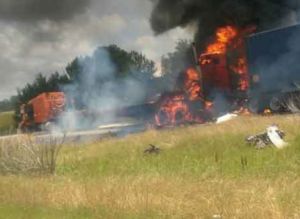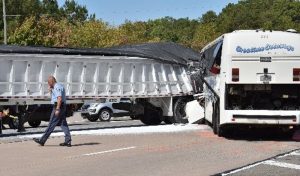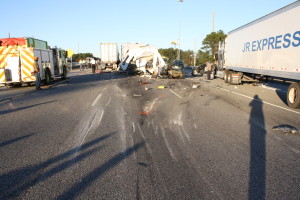
Sleep deprivation among overworked big rig truck drivers is a well-known safety hazard on the highways. For years there have been political, regulatory and court battles over which driver fatigue and hours-of-service regulations should be implemented.
It is intuitive common sense that sleep deprivation reduces alertness in any job, including one that involves operating an 80,000 pound vehicle across the county on our highways so that dozing off can be a major threat to safety of others. Truck drivers are not different from the rest of us. They just operate bigger machines on the roads.
Now we have a little more science to explain the need for sleep. Researchers at the University of Rochester have found that sleep serves a function of cleaning out toxic waste products produced by cells in the brain that accumulates while we are awake. Those byproducts include beta-amyloid protein, clumps of which form plaques found in the brains of Alzheimer’s patients. Other neurodegenerative disorders, such as Parkinson’s disease or chronic traumatic encephalopathy, are also associated with a backup of too much cell waste in the brain.
Thus, sleep has been called the “ultimate brain washer.”
As we sleep, neurons shrink, widening channels for cerebrospinal fluid to flush out metabolites, cellular waste products, twice as fast. This a network that drains waste from the brain, called the glymphatic system, works by circulating cerebrospinal fluid throughout the brain tissue and flushing waste into the bloodstream, which then carries it to the liver for detoxification and elimination. All of us need sleep to allow this to happen.
When we become chronically sleep derived, gunk builds up in our brains. As most of us have experienced, too little sleep causes slower reactions, worse decision making, mental fog and crankiness. If sleep deprivation persists, it can cause increased risks of migraines, seizures and even death. As the body craves sleep, it will take precedence over our work duties.
In my law practice, I have often discussed fatigue issues with truck drivers. One who stands out in my memory was a trucker from Ohio who reluctantly admitted in deposition that his entire log was falsified to make his trips look good. But the truth was that he had been driving 20 of the previous 24 hours when he hit a family and killed their son. His plan to was to make a quick turnaround in Atlanta and go straight back to Ohio. If he had made it that far, he would have been driving for something like 32 hours out of 40. His employer had no system in place to guard against that. A federal judge stated in an order that the company “turned a blind eye to safety.”
Other interstate truck drivers have told me informally, sometimes over many cups of coffee at a Waffle House or truck stop along the interstate, of being pressured by trucking companies, shipper and brokers to make delivery runs that could not possibly be made without violating hours-of-service rules. Sometimes there are long delays in getting loads, which they are then expected to get across the country by a delivery deadline that is not adjusted to the load time. The entire malfunction of the logistics system is dumped on the weary shoulders of a truck driver who is only human.
That is why in trucking cases we seek the root cause of a crash, which often is in the company’s management system that ignores the body’s need for rest, rather just a tired driver’s actions in the last ten seconds before a crash.
Most of us who have endured long periods of chronic sleep deprivation due to demands of work, parenting or other activities, can relate to the effects of chronic fatigue and sleep deprivation on professional truck drivers. While there is a temptation to take pride in ability to soldier on without adequate sleep, biology ultimately catches up with us all.
Continue reading →
 Throughout history, epidemics have swept through populations. Waves of pandemic — bubonic plague, cholera, smallpox and influenza — have killed hundreds of millions of people. Now we face the COVID-19 pandemic.
Throughout history, epidemics have swept through populations. Waves of pandemic — bubonic plague, cholera, smallpox and influenza — have killed hundreds of millions of people. Now we face the COVID-19 pandemic. Georgia Truck Accident Attorney Blog
Georgia Truck Accident Attorney Blog








